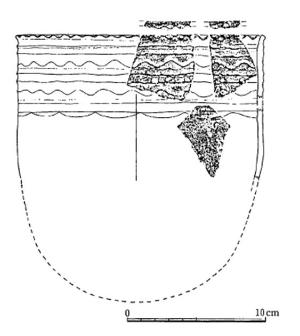Items excavated from the ruins of Komazawa Gakuen School grounds
Updated: October 29, 2018

Early Jomon period earthenware and stone tools
Komazawa Gakuen Campus Site Ruins
With the construction of the Komazawa Gakuen school, 6 Remains of Excavations This was carried out from 1984 to 1987. Remains is located in the hills of Sakahama, Jomon Period from Heian period , Edo Period Over Complex ruins is. Remains The center of Jomon Period So, in the early and mid-term Remains of a pit dwelling Three cooking facilities made from collected stones. Stone collection site 57 units, For hunting of Recess death hole Earth Pit Six of these were discovered. Remains As, Remains From a point east of The Beginning of the Jomon Period and early Relics Concentration Area was discovered, and from there Excavated did Earthenware or stone tool Eight of these have been designated as Inagi City tangible cultural properties. Among them, Earthenware with slightly raised lines is the oldest in the Inagi City area. Jomon pottery It attracted attention as:
The Beginning of the Jomon Period Materials
The early days of Earthenware and Stone tools We will introduce the following. Earthenware teeth, Earthenware with slightly raised lines It is called the "Great Wall of the Buddha" and is thought to have been built around 12,000 years ago. Mouth rim and Body It consists of three pieces, straight and wavy thin pieces. Ridge line The feature is that it is attached. Earthenware with slightly raised lines When the whole of the statue was restored, it would have a diameter of about 18.3 centimeters and a height of about 20 centimeters. Round bottom of Deep bowl-shaped pottery It is estimated that this will be the case (see figure below). Stone tools is the aforementioned Earthenware with slightly raised lines A total of four items were excavated, which are believed to be hunting tools from the same period. Two of them are Lingual point It is called, The early days Characteristic of Hunting equipment is. base To tongue A pointed tip with a barb shaped like a Stone tools Also, one point is, Point It is slender with thin edges on both sides. Sawtooth It has a jagged shape like the teeth of a saw. base Although it lacks Tongue With Lingual point Another point is the wedge shape. Stone tools is. Paleolithic from Jomon period By Excavated do Stone tools However, Excavated From that position, Earthenware with slightly raised lines It is thought to be from the same period. Triangular Pyramid It has the following shape.

Restoration drawing of earthenware with fine ridge line design
Materials from the early and middle Jomon period
At the same location Stone collection site (where stones were collected for cooking, etc.) Jomon Period Early and Middle Periods Earthenware Three points Excavated I did. 1 point Jomon Period Previous period Deep bowl-shaped pottery It is about 24 centimeters tall and 17 centimeters in diameter. It looks like a rope is pressed against the entire surface. Pattern The pieces are marked with a "Tsukubai" (traditional Japanese marking) and are simply made with little decoration, characteristic of the earlier period. The remaining pieces are pottery from the middle Jomon period, and were produced mainly in Chiba and Ibaraki prefectures, but are thought to have been brought to Inagi via trade or other means. One of the pieces is a large deep bowl-shaped vessel, approximately 40 centimeters in height and 28 centimeters in diameter. Mouth rim 4 in handle There are Earthenware From above Linear Put soil on it. Pattern Another one is also available. Deep bowl-shaped pottery It is 27cm tall and has a diameter of 22cm. Mouth rim In the same way Elevation did Band of Pattern there is.








